Do Lizards Shed Their Skin
| Lizards Temporal range: Early Jurassic – Holocene, Possible Late Triassic record | |
|---|---|
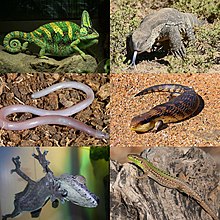 | |
| Clockwise from top left: veiled chameleon (Chamaeleo calyptratus), stone monitor (Varanus albigularis), mutual blue-tongued skink (Tiliqua scincoides), Italian wall lizard (Podarcis sicula), behemothic leaf-tailed gecko (Uroplatus fimbriatus), and legless lizard (Anelytropsis papillosus) | |
| Scientific classification | |
| Kingdom: | Animalia |
| Phylum: | Chordata |
| Class: | Reptilia |
| Superorder: | Lepidosauria |
| Order: | Squamata |
| Groups included | |
| |
 | |
| Range of the lizards, all species. | |
| Cladistically included merely traditionally excluded taxa | |
| |
| Synonyms | |
| Sauria Macartney, 1802 | |
Lizards (suborder Lacertilia) are a widespread group of squamate reptiles, with over vi,000 species,[1] ranging beyond all continents except Antarctica, too as most oceanic isle chains. The grouping is paraphyletic as information technology excludes the snakes and Amphisbaenia; some lizards are more than closely related to these two excluded groups than they are to other lizards. Lizards range in size from chameleons and geckos a few centimeters long to the 3 meter long Komodo dragon.
Virtually lizards are quadrupedal, running with a strong side-to-side motion. Some lineages (known as "legless lizards"), take secondarily lost their legs, and have long snake-like bodies. Some such as the wood-domicile Draco lizards are able to glide. They are often territorial, the males fighting off other males and signalling, often with brightly colours, to concenter mates and to intimidate rivals. Lizards are mainly carnivorous, ofttimes being sit down-and-wait predators; many smaller species swallow insects, while the Komodo eats mammals every bit big as water buffalo.
Lizards make use of a variety of antipredator adaptations, including venom, camouflage, reflex haemorrhage, and the power to sacrifice and regrow their tails.
Anatomy
Largest and smallest
The adult length of species within the suborder ranges from a few centimeters for chameleons such equally Brookesia micra and geckos such as Sphaerodactylus ariasae [2] to nearly 3 m (10 ft) in the instance of the largest living varanid lizard, the Komodo dragon.[3] Most lizards are adequately small animals.
Distinguishing features
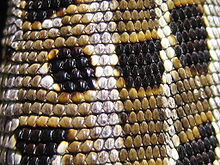

Lizards typically have rounded torsos, elevated heads on brusque necks, four limbs and long tails, although some are legless.[4] Lizards and snakes share a movable quadrate bone, distinguishing them from the rhynchocephalians, which have more than rigid diapsid skulls.[5] Some lizards such as chameleons accept prehensile tails, assisting them in climbing among vegetation.[6]
As in other reptiles, the skin of lizards is covered in overlapping scales made of keratin. This provides protection from the environment and reduces water loss through evaporation. This adaptation enables lizards to thrive in some of the driest deserts on earth. The skin is tough and leathery, and is shed (sloughed) as the fauna grows. Different snakes which shed the skin in a single piece, lizards slough their skin in several pieces. The scales may exist modified into spines for display or protection, and some species have bone osteoderms underneath the scales.[half-dozen] [7]

The dentitions of lizards reflect their wide range of diets, including carnivorous, insectivorous, omnivorous, herbivorous, nectivorous, and molluscivorous. Species typically accept compatible teeth suited to their diet, but several species take variable teeth, such as cutting teeth in the forepart of the jaws and crushing teeth in the rear. Nigh species are pleurodont, though agamids and chameleons are acrodont.[8] [6]
The tongue can exist extended outside the rima oris, and is often long. In the beaded lizards, whiptails and monitor lizards, the tongue is forked and used mainly or exclusively to sense the environs, continually flicking out to sample the environs, and back to transfer molecules to the vomeronasal organ responsible for chemosensation, analogous to but unlike from scent or taste. In geckos, the natural language is used to lick the eyes make clean: they have no eyelids. Chameleons have very long sticky tongues which can exist extended rapidly to catch their insect prey.[vi]
3 lineages, the geckos, anoles, and chameleons, have modified the scales under their toes to form adhesive pads, highly prominent in the offset two groups. The pads are composed of millions of tiny setae (hair-like structures) which fit closely to the substrate to adhere using van der Waals forces; no liquid adhesive is needed.[9] In improver, the toes of chameleons are divided into 2 opposed groups on each foot (zygodactyly), enabling them to perch on branches as birds do.[a] [6]
Physiology
Locomotion

Adhesive pads enable geckos to climb vertically.
Aside from legless lizards, near lizards are quadrupedal and movement using gaits with alternating movement of the correct and left limbs with substantial body bending. This body bending prevents pregnant respiration during movement, limiting their endurance, in a mechanism called Carrier's constraint. Several species can run bipedally,[x] and a few tin can prop themselves up on their hindlimbs and tail while stationary. Several small species such as those in the genus Draco can glide: some can attain a altitude of 60 metres (200 feet), losing 10 metres (33 feet) in pinnacle.[11] Some species, like geckos and chameleons, adhere to vertical surfaces including glass and ceilings.[ix] Some species, similar the common basilisk, can run into water.[12]
Senses
Lizards make use of their senses of sight, bear on, olfaction and hearing like other vertebrates. The residuum of these varies with the habitat of different species; for case, skinks that live largely covered by loose soil rely heavily on olfaction and touch, while geckos depend largely on acute vision for their power to chase and to evaluate the altitude to their prey before striking. Monitor lizards have acute vision, hearing, and olfactory senses. Some lizards brand unusual use of their sense organs: chameleons tin steer their eyes in different directions, sometimes providing not-overlapping fields of view, such equally forwards and backwards at once. Lizards lack external ears, having instead a circular opening in which the tympanic membrane (eardrum) tin can exist seen. Many species rely on hearing for early warning of predators, and flee at the slightest sound.[13]
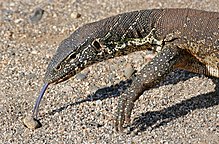
Nile monitor using its tongue for odour
Equally in snakes and many mammals, all lizards take a specialised olfactory system, the vomeronasal organ, used to detect pheromones. Monitor lizards transfer scent from the tip of their tongue to the organ; the tongue is used only for this information-gathering purpose, and is not involved in manipulating food.[xiv] [xiii]
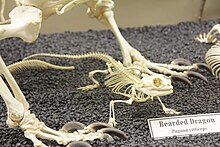
Some lizards, specially iguanas, have retained a photosensory organ on the top of their heads chosen the parietal eye, a basal ("primitive") feature besides present in the tuatara. This "center" has only a rudimentary retina and lens and cannot form images, but is sensitive to changes in calorie-free and dark and tin detect motion. This helps them find predators stalking it from higher up.[xv]
Venom
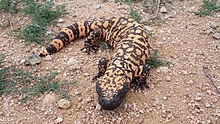
Until 2006 it was idea that the Gila monster and the Mexican beaded lizard were the but venomous lizards. However, several species of monitor lizards, including the Komodo dragon, produce powerful venom in their oral glands. Lace monitor venom, for instance, causes swift loss of consciousness and extensive bleeding through its pharmacological effects, both lowering blood pressure and preventing blood clotting. Nine classes of toxin known from snakes are produced by lizards. The range of actions provides the potential for new medicinal drugs based on lizard venom proteins.[16] [17]
Genes associated with venom toxins accept been plant in the salivary glands on a wide range of lizards, including species traditionally idea of as not-venomous, such as iguanas and bearded dragons. This suggests that these genes evolved in the common ancestor of lizards and snakes, some 200 million years ago (forming a unmarried clade, the Toxicofera).[16] However, well-nigh of these putative venom genes were "housekeeping genes" constitute in all cells and tissues, including skin and cloacal scent glands. The genes in question may thus be evolutionary precursors of venom genes.[18]
Respiration
Recent studies (2013 and 2014) on the lung beefcake of the savannah monitor and green iguana found them to accept a unidirectional airflow arrangement, which involves the air moving in a loop through the lungs when breathing. This was previously thought to just be in the archosaurs (crocodilians and birds). This may be show that unidirectional airflow is an ancestral trait in diapsids.[19] [20]
Reproduction and lifecycle

Trachylepis maculilabris skinks mating
As with all amniotes, lizards rely on internal fertilisation and copulation involves the male inserting i of his hemipenes into the female'south cloaca.[21] The majority of species are oviparous (egg laying). The female deposits the eggs in a protective structure like a nest or crevice or but on the basis.[22] Depending on the species, clutch size can vary from iv–5 percent of the females body weight to twoscore–50 per centum and clutches range from one or a few large eggs to dozens of pocket-sized ones.[23]

In near lizards, the eggs accept leathery shells to allow for the commutation of water, although more than arid-living species have calcified shells to retain h2o. Inside the eggs, the embryos use nutrients from the yolk. Parental care is uncommon and the female usually abandons the eggs after laying them. Heart-searching and protection of eggs does occur in some species. The female prairie skink uses respiratory h2o loss to maintain the humidity of the eggs which facilitates embryonic evolution. In lace monitors, the young hatch shut to 300 days, and the female returns to help them escape the termite mound where the eggs were laid.[22]
Around 20 percentage of lizard species reproduce via viviparity (live birth). This is particularly common in Anguimorphs. Viviparous species give birth to relatively adult young which look similar miniature adults. Embryos are nourished via a placenta-similar structure.[24] A minority of lizards have parthenogenesis (reproduction from unfertilised eggs). These species consist of all females who reproduce asexually with no need for males. This is known in occur in diverse species of whiptail lizards.[25] Parthenogenesis was also recorded in species that normally reproduce sexually. A captive female person Komodo dragon produced a clutch of eggs, despite being separated from males for over two years.[26]
Sexual activity determination in lizards can be temperature-dependent. The temperature of the eggs' micro-environment can determine the sexual activity of the hatched young: low temperature incubation produces more females while higher temperatures produce more males. However, some lizards have sex activity chromosomes and both male heterogamety (XY and XXY) and female heterogamety (ZW) occur.[25]
Behaviour
Diurnality and thermoregulation
The majority of lizard species are active during the mean solar day,[27] though some are active at dark, notably geckos. As ectotherms, lizards have a limited power to regulate their torso temperature, and must seek out and bask in sunlight to gain enough heat to become fully agile.[28]
In high altitudes, the Podarcis hispaniscus responds to college temperature with a darker dorsal coloration to forbid UV-radiation and background matching. Their thermoregulatory mechanisms also allow the lizard to maintain their ideal body temperature for optimal mobility.[29]
Territoriality

Near social interactions amongst lizards are betwixt breeding individuals.[27] Territoriality is common and is correlated with species that employ sit-and-wait hunting strategies. Males found and maintain territories that contain resource which attract females and which they defend from other males. Important resources include basking, feeding, and nesting sites as well as refuges from predators. The habitat of a species affects the structure of territories, for example, rock lizards take territories atop rocky outcrops.[xxx] Some species may amass in groups, enhancing vigilance and lessening the risk of predation for individuals, specially for juveniles.[31] Agonistic behaviour typically occurs between sexually mature males over territory or mates and may involve displays, posturing, chasing, grappling and biting.[30]
Communication

Lizards betoken both to attract mates and to intimidate rivals. Visual displays include body postures and aggrandizement, button-ups, bright colours, mouth gapings and tail waggings. Male anoles and iguanas have dewlaps or peel flaps which come up in various sizes, colours and patterns and the expansion of the dewlap as well as caput-bobs and torso movements add to the visual signals.[32] [half-dozen] Some species have deep blueish dewlaps and communicate with ultraviolet signals.[27] Bluish-tongued skinks will flash their tongues as a threat display.[33] Chameleons are known to change their complex colour patterns when communicating, particularly during agonistic encounters. They tend to evidence brighter colours when displaying aggression[34] and darker colours when they submit or "give upward".[35]
Several gecko species are brightly coloured; some species tilt their bodies to display their coloration. In certain species, brightly coloured males turn boring when non in the presence of rivals or females. While it is usually males that display, in some species females also use such communication. In the bronze anole, head-bobs are a common course of communication among females, the speed and frequency varying with historic period and territorial condition. Chemic cues or pheromones are besides important in advice. Males typically direct signals at rivals, while females direct them at potential mates. Lizards may be able to recognise individuals of the same species by their scent.[32]
Acoustic communication is less common in lizards. Hissing, a typical reptilian sound, is mostly produced by larger species as part of a threat display, accompanying gaping jaws. Some groups, particularly geckos, snake-lizards, and some iguanids, can produce more complex sounds and vocal apparatuses have independently evolved in different groups. These sounds are used for courting, territorial defense and in distress, and include clicks, squeaks, barks and growls. The mating call of the male tokay gecko is heard as "tokay-tokay!".[33] [32] [36] Tactile advice involves individuals rubbing confronting each other, either in courting or in aggression.[32] Some chameleon species communicate with one some other by vibrating the substrate that they are standing on, such as a tree branch or foliage.[37]
Ecology

Cadger in tree. Many species are tree-dwelling house

A lizard from Thar desert
Distribution and habitat
Lizards are found worldwide, excluding the far north and Antarctica, and some islands. They can be found in elevations from sea level to five,000 m (sixteen,000 ft). They prefer warmer, tropical climates but are adaptable and tin alive in all but the most extreme environments. Lizards also exploit a number of habitats; most primarily alive on the ground, simply others may live in rocks, on trees, underground and even in water. The marine iguana is adapted for life in the sea.[six]
Diet
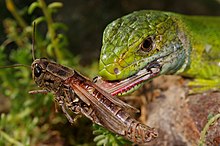
The majority of lizard species are predatory and the near common prey items are modest, terrestrial invertebrates, particularly insects.[6] [38] Many species are sit-and-await predators though others may be more active foragers.[39] Chameleons casualty on numerous insect species, such as beetles, grasshoppers and winged termites also every bit spiders. They rely on persistence and ambush to capture these prey. An individual perches on a branch and stays perfectly yet, with only its eyes moving. When an insect lands, the chameleon focuses its eyes on the target and slowly moves towards it before projecting its long pasty tongue which, when hauled back, brings the attach casualty with it. Geckos feed on crickets, beetles, termites and moths.[6] [38]
Termites are an important part of the diets of some species of Autarchoglossa, since, as social insects, they tin be found in large numbers in one spot. Ants may grade a prominent part of the diet of some lizards, specially among the lacertas.[6] [38] Horned lizards are also well known for specializing on ants. Due to their small size and indigestible chitin, ants must be consumed in large amounts, and ant-eating lizards have larger stomachs than even herbivorous ones.[40] Species of skink and alligator lizards eat snails and their ability jaws and tooth-like teeth are adjusted for breaking the shells.[6] [38]


Marine iguana foraging under water at Galápagos Islands, Ecuador.
Larger species, such as monitor lizards, tin can feed on larger prey including fish, frogs, birds, mammals and other reptiles. Prey may be swallowed whole and torn into smaller pieces. Both bird and reptile eggs may also exist consumed as well. Gila monsters and beaded lizards climb trees to reach both the eggs and young of birds. Despite being venomous, these species rely on their potent jaws to kill casualty. Mammalian prey typically consists of rodents and leporids; the Komodo dragon can kill prey every bit large as water buffalo. Dragons are prolific scavengers, and a single decaying carcass can concenter several from 2 km (ane.2 mi) abroad. A 50 kg (110 lb) dragon is capable of consuming a 31 kg (68 lb) carcass in 17 minutes.[38]
Around 2 pct of cadger species, including many iguanids, are herbivores. Adults of these species eat establish parts like flowers, leaves, stems and fruit, while juveniles consume more insects. Plant parts can exist difficult to digest, and, as they go closer to adulthood, juvenile iguanas swallow faeces from adults to acquire the microflora necessary for their transition to a plant-based nutrition. Perhaps the most herbivorous species is the marine iguana which dives 15 grand (49 ft) to forage for algae, kelp and other marine plants. Some non-herbivorous species supplement their insect diet with fruit, which is hands digested.[half-dozen] [38]
Antipredator adaptations
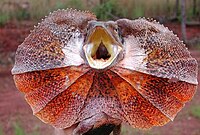
The frilled-neck lizard with fully extended frill. The frilled serves to arrive look bigger than information technology actually is.
Lizards have a variety of antipredator adaptations, including running and climbing, venom, camouflage, tail autotomy, and reflex haemorrhage.
Camouflage

Lizards exploit a diverseness of different camouflage methods. Many lizards are disruptively patterned. In some species, such as Aegean wall lizards, individuals vary in colour, and select rocks which best friction match their ain colour to minimise the risk of existence detected by predators.[41] The Moorish gecko is able to change colour for camouflage: when a light-coloured gecko is placed on a dark surface, information technology darkens within an hr to match the environment.[42] The chameleons in general use their power to alter their coloration for signalling rather than camouflage, simply some species such equally Smith'south dwarf chameleon exercise use active colour change for camouflage purposes.[43]
The flat-tail horned lizard's body is coloured similar its desert groundwork, and is flattened and fringed with white scales to minimise its shadow.[44]
Autotomy
A skink tail continuing to move after autotomy
Many lizards, including geckos and skinks, are capable of shedding their tails (autotomy). The detached tail, sometimes brilliantly coloured, continues to writhe after detaching, distracting the predator'south attention from the fleeing prey. Lizards partially regenerate their tails over a flow of weeks. Some 326 genes are involved in regenerating lizard tails.[45] The fish-scale gecko Geckolepis megalepis sheds patches of skin and scales if grabbed.[46]
Escape, playing dead, reflex haemorrhage
Many lizards attempt to escape from danger past running to a place of safety;[47] [b] for example, wall lizards tin can run up walls and hide in holes or cracks.[ix] Horned lizards prefer differing defences for specific predators. They may play dead to deceive a predator that has defenseless them; attempt to outrun the rattlesnake, which does not pursue casualty; but stay nevertheless, relying on their cryptic coloration, for Masticophis whip snakes which can catch even swift prey. If caught, some species such as the greater brusk-horned lizard puff themselves up, making their bodies hard for a narrow-mouthed predator similar a whip snake to swallow. Finally, horned lizards can squirt blood at cat and dog predators from a pouch beneath its eyes, to a distance of about two metres (six.6 feet); the blood tastes foul to these attackers.[49]
Evolution
Fossil history

The earliest known fossil remains of a lizard belong to the iguanian species Tikiguania estesi, plant in the Tiki Formation of Republic of india, which dates to the Carnian stage of the Triassic menstruation, about 220 one thousand thousand years agone.[50] However, doubt has been raised over the age of Tikiguania because information technology is almost indistinguishable from mod agamid lizards. The Tikiguania remains may instead be tardily Third or Quaternary in historic period, having been washed into much older Triassic sediments.[51] Lizards are most closely related to the Rhynchocephalia, which appeared in the Late Triassic, so the earliest lizards probably appeared at that time.[51] Mitochondrial phylogenetics suggest that the offset lizards evolved in the late Permian. It had been idea on the basis of morphological data that iguanid lizards diverged from other squamates very early on, simply molecular show contradicts this.[52]
Mosasaurs probably evolved from an extinct group of aquatic lizards[53] known as aigialosaurs in the Early on Cretaceous. Dolichosauridae is a family of Tardily Cretaceous aquatic varanoid lizards closely related to the mosasaurs.[54] [55]
Phylogeny
External
The position of the lizards and other Squamata among the reptiles was studied using fossil evidence by Rainer Schoch and Hans-Dieter Sues in 2015. Lizards form virtually 60% of the extant non-avian reptiles.[56]
Internal
Both the snakes and the Amphisbaenia (worm lizards) are clades deep within the Squamata (the smallest clade that contains all the lizards), and so "lizard" is paraphyletic.[57] The cladogram is based on genomic analysis past Wiens and colleagues in 2012 and 2016.[58] [59] Excluded taxa are shown in upper case on the cladogram.
Taxonomy

In the 13th century, lizards were recognized in Europe as part of a broad category of reptiles that consisted of a miscellany of egg-laying creatures, including "snakes, diverse fantastic monsters, […], assorted amphibians, and worms", every bit recorded by Vincent of Beauvais in his Mirror of Nature.[threescore] The seventeenth century saw changes in this loose description. The proper name Sauria was coined by James Macartney (1802);[61] information technology was the Latinisation of the French name Sauriens, coined by Alexandre Brongniart (1800) for an order of reptiles in the classification proposed by the writer, containing lizards and crocodilians,[62] later on discovered non to exist each other's closest relatives. Afterward authors used the term "Sauria" in a more restricted sense, i.e. as a synonym of Lacertilia, a suborder of Squamata that includes all lizards but excludes snakes. This nomenclature is rarely used today because Sauria so-divers is a paraphyletic group. It was divers as a clade past Jacques Gauthier, Arnold G. Kluge and Timothy Rowe (1988) every bit the group containing the most recent common ancestor of archosaurs and lepidosaurs (the groups containing crocodiles and lizards, equally per Mcartney's original definition) and all its descendants.[63] A different definition was formulated by Michael deBraga and Olivier Rieppel (1997), who defined Sauria as the clade containing the most contempo common ancestor of Choristodera, Archosauromorpha, Lepidosauromorpha and all their descendants.[64] However, these uses accept not gained wide acceptance amid specialists.
Suborder Lacertilia (Sauria) – (lizards)
- Family †Bavarisauridae
- Family †Eichstaettisauridae
- Infraorder Iguania
- Family unit †Arretosauridae
- Family unit †Euposauridae
- Family Corytophanidae (casquehead lizards)
- Family Iguanidae (iguanas and spinytail iguanas)
- Family Phrynosomatidae (earless, spiny, tree, side-blotched and horned lizards)
- Family Polychrotidae (anoles)
- Family Leiosauridae (see Polychrotinae)
- Family unit Tropiduridae (neotropical footing lizards)
- Family Liolaemidae (come across Tropidurinae)
- Family Leiocephalidae (encounter Tropidurinae)
- Family unit Crotaphytidae (collared and leopard lizards)
- Family Opluridae (Republic of madagascar iguanids)
- Family Hoplocercidae (wood lizards, clubtails)
- Family †Priscagamidae
- Family unit †Isodontosauridae
- Family Agamidae (agamas, frilled lizards)
- Family Chamaeleonidae (chameleons)
- Infraorder Gekkota
- Family Gekkonidae (geckos)
- Family unit Pygopodidae (legless geckos)
- Family Dibamidae (blind lizards)
- Infraorder Scincomorpha
- Family †Paramacellodidae
- Family †Slavoiidae
- Family Scincidae (skinks)
- Family unit Cordylidae (spinytail lizards)
- Family Gerrhosauridae (plated lizards)
- Family unit Xantusiidae (night lizards)
- Family Lacertidae (wall lizards or true lizards)
- Family †Mongolochamopidae
- Family †Adamisauridae
- Family Teiidae (tegus and whiptails)
- Family Gymnophthalmidae (spectacled lizards)
- Infraorder Diploglossa
- Family unit Anguidae (slowworms, glass lizards)
- Family unit Anniellidae (American legless lizards)
- Family unit Xenosauridae (knob-scaled lizards)
- Infraorder Platynota (Varanoidea)
- Family Varanidae (monitor lizards)
- Family Lanthanotidae (earless monitor lizards)
- Family unit Helodermatidae (Gila monsters and beaded lizards)
- Family †Mosasauridae (marine lizards)

Convergence
Lizards have often evolved convergently, with multiple groups independently developing similar morphology and ecological niches. Anolis ecomorphs have become a model organization in evolutionary biology for studying convergence.[66] Limbs take been lost or reduced independently over two dozen times across lizard evolution, including in the Anniellidae, Anguidae, Cordylidae, Dibamidae, Gymnophthalmidae, Pygopodidae, and Scincidae; snakes are just the nearly famous and species-rich group of Squamata to take followed this path.[65]
Relationship with humans
Most lizard species are harmless to humans. Only the largest lizard species, the Komodo dragon, which reaches 3.3 thou (11 ft) in length and weighs up to 166 kg (366 lb), has been known to stem, assail, and, on occasion, kill humans. An eight-year-quondam Indonesian boy died from claret loss after an attack in 2007.[67]

Numerous species of lizard are kept as pets, including bearded dragons,[68] iguanas, anoles,[69] and geckos (such as the popular leopard gecko).[68]Monitor lizards such every bit the savannah monitor and tegus such as the Argentine tegu and cherry-red tegu are too kept.

Ruby tegu drinking water out of a dispenser.
Lizards appear in myths and folktales effectually the world. In Australian Aboriginal mythology, Tarrotarro, the lizard god, split the human race into male and female, and gave people the power to express themselves in art. A lizard king named Mo'o features in Hawaii and other cultures in Polynesia. In the Amazon, the cadger is the male monarch of beasts, while among the Bantu of Africa, the god UNkulunkulu sent a chameleon to tell humans they would live forever, merely the chameleon was held upwards, and another lizard brought a dissimilar bulletin, that the time of humanity was limited.[70] A popular legend in Maharashtra tells the tale of how a common Indian monitor, with ropes attached, was used to calibration the walls of the fort in the Battle of Sinhagad.[71] In the Bhojpuri speaking region of India and Nepal, in that location is a belief among children that, on touching skink's tail three (or 5) fourth dimension with the shortest finger gives money.
Light-green iguanas are eaten in Central America, where they are sometimes referred to equally "chicken of the tree" subsequently their addiction of resting in copse and their supposedly craven-similar gustatory modality,[72] while spiny-tailed lizards are eaten in Africa. In N Africa, Uromastyx species are considered dhaab or 'fish of the desert' and eaten by nomadic tribes.[73]
Lizards such every bit the Gila monster produce toxins with medical applications. Gila toxin reduces plasma glucose; the substance is at present synthesized for apply in the anti-diabetes drug exenatide (Byetta).[17] Another toxin from Gila monster saliva has been studied for use as an anti-Alzheimer's drug.[74]
Lizards in many cultures share the symbolism of snakes, especially as an emblem of resurrection. This may accept derived from their regular molting. The motif of lizards on Christian candle holders probably alludes to the same symbolism. According to Jack Tresidder, in Egypt and the Classical world they were beneficial emblems, linked with wisdom. In African, Ancient and Melanesian folklore they are linked to cultural heroes or ancestral figures.[75]
Notes
- ^ Chameleon forefeet have groups composed of 3 inner and 2 outer digits; the hindfeet accept groups of 2 inner and 3 outer digits.[6]
- ^ The BBC'southward 2016 Planet Earth II showed a sequence of newly-hatched marine iguanas running to the sea by a waiting crowd of racer snakes. Information technology was edited for dramatic effect simply the sections were all genuine.[48]
References
- ^ Reptile Database. Retrieved on 2012-04-22
- ^ Muir, Hazel (3 December 2001). "Infinitesimal gecko matches smallest reptile record". New Scientist.
- ^ "The world'due south top 10 reptiles – in pictures". The Guardian. five May 2016.
- ^ McDiarmid, Roy West. (2012). "Reptile Diverseness and Natural History: An Overview". In McDiarmid, Roy W.; et al. (eds.). Reptile Biodiversity: Standard Methods for Inventory and Monitoring. p. xiii. ISBN978-0520266711.
- ^ Jones; et al. (2011). "Hard tissue anatomy of the cranial joints in Sphenodon (Rhynchocephalia): sutures, kinesis, and skull mechanics". Palaeontologia Electronica. fourteen(2, 17A): 1–92.
- ^ a b c d e f g h i j k l yard Bauer, A. M.; Kluge, A. Thousand.; Schuett, One thousand. (2002). "Lizards". In Halliday, T.; Adler, K. (eds.). The Firefly Encyclopedia of Reptiles and Amphibians. Firefly Books. pp. 139–169. ISBN978-1-55297-613-v.
- ^ Starr, C.; Taggart, R.; Evers, C. (2012). Biology: The Unity and Diverseness of Life. Cengage Learning. p. 429. ISBN978-1111425692.
- ^ Pough; et al. (2002) [1992]. Herpetology (3rd ed.). Pearson Prentice Hall.
- ^ a b c Spinner, Marlene; et al. (2014). "Subdigital setae of chameleon anxiety: Friction-enhancing microstructures for a wide range of substrate roughness". Scientific Reports. 4: 5481. Bibcode:2014NatSR...4E5481S. doi:ten.1038/srep05481. PMC4073164. PMID 24970387.
- ^ Irschick, D. J.; Jayne, B. C. (1 May 1999). "Comparative 3-dimensional kinematics of the hindlimb for high-speed bipedal and quadrupedal locomotion of lizards". Journal of Experimental Biology. 202 (9): 1047–1065. doi:ten.1242/jeb.202.ix.1047. PMID 10101105 – via jeb.biologists.org.
- ^ Piper, Ross (2007), Extraordinary Animals: An Encyclopedia of Curious and Unusual Animals, Greenwood Press.
- ^ Pianka and Vitt, 23–24
- ^ a b Wilson, Steve (2012). Australian Lizards: A Natural History. Csiro Publishing. pp. 65–74. ISBN978-0-643-10642-0.
- ^ Frasnelli, J.; et al. (2011). "The vomeronasal organ is non involved in the perception of endogenous odors". Hum. Encephalon Mapp. 32 (3): 450–sixty. doi:10.1002/hbm.21035. PMC3607301. PMID 20578170.
- ^ Brames, Henry (2007), "Aspects of Lite and Reptile Amnesty" (PDF), Iguana: Conservation, Natural History, and Husbandry of Reptiles, xiv (i): 19–23 [ permanent dead link ]
- ^ a b Fry, Bryan G.; et al. (xvi November 2005). "Early evolution of the venom arrangement in lizards and snakes". Nature. 439 (7076): 584–588. Bibcode:2006Natur.439..584F. doi:ten.1038/nature04328. PMID 16292255. S2CID 4386245.
- ^ a b Casey, Constance (26 Apr 2013). "Don't Call It a Monster". Slate.
- ^ Hargreaves, Adam D.; et al. (2014). "Testing the Toxicofera: Comparative transcriptomics casts doubt on the single, early on development of the reptile venom system". Toxicon. 92: 140–156. doi:10.1016/j.toxicon.2014.10.004. PMID 25449103.
- ^ Schachner, Emma R.; Cieri, Robert L.; Butler, James P.; Farmer, C. G. (2014). "Unidirectional pulmonary airflow patterns in the savannah monitor lizard". Nature. 506 (7488): 367–370. Bibcode:2014Natur.506..367S. doi:10.1038/nature12871. PMID 24336209. S2CID 4456381.
- ^ Robert Fifty.; Craven, Brent A.; Schachner, Emma R.; Farmer, C. Yard. (2014). "New insight into the development of the vertebrate respiratory system and the discovery of unidirectional airflow in iguana lungs". PNAS. 111 (48): 17218–17223. Bibcode:2014PNAS..11117218C. doi:ten.1073/pnas.1405088111. PMC4260542. PMID 25404314.
- ^ Pianka and Vitt, pp. 108.
- ^ a b Pianka and Vitt, pp. 115–116.
- ^ Pianka and Vitt, pp. 110–111.
- ^ Pianka and Vitt, pp. 117–118.
- ^ a b Pianka and Vitt, pp. 119.
- ^ Morales, Alex (20 December 2006). "Komodo Dragons, World's Largest Lizards, Take Virgin Births". Bloomberg Television. Retrieved 28 March 2008.
- ^ a b c Pianka and Vitt, pp. 86.
- ^ Pianka and Vitt, pp. 32–37.
- ^ Ortega, Jesús; Martín, José; Crochet, Pierre-André; López, Pilar; Clobert, Jean (2019-03-15). "Seasonal and interpopulational phenotypic variation in morphology and sexual signals of Podarcis liolepis lizards". PLOS One. 14 (3): e0211686. Bibcode:2019PLoSO..1411686O. doi:ten.1371/journal.pone.0211686. ISSN 1932-6203. PMC6419997. PMID 30875384.
- ^ a b Pianka and Vitt, pp. 94–106.
- ^ Lanham, E. J.; Bull. K. C. (2004). "Enhanced vigilance in groups in Egernia stokesii, a lizard with stable social aggregations". Periodical of Zoology. 263 (one): 95–99. doi:10.1017/S0952836904004923.
- ^ a b c d Pianka and Vitt, pp. 87–94.
- ^ a b Langley, Fifty. (24 October 2015). "Are Lizards equally Silent every bit They Seem?". news.nationalgeographic.com. Retrieved 9 July 2017.
- ^ Ligon, Russell A.; McGraw, Kevin J. (2013). "Chameleons communicate with complex colour changes during contests: different body regions convey different information". Biology Letters. ix (6): 20130892. doi:ten.1098/rsbl.2013.0892. PMC3871380. PMID 24335271.
- ^ Ligon, Russell A (2014). "Defeated chameleons darken dynamically during dyadic disputes to decrease danger from dominants". Behavioral Ecology and Sociobiology. 68 (6): 1007–1017. doi:10.1007/s00265-014-1713-z. S2CID 18606633.
- ^ Frankenberg, E.; Werner, Y. L. (1992). "Vocal communication in the Reptilia–facts and questions". 41. Acta Zoologica: 45–62.
- ^ Barnett, Grand. E.; Cocroft, R. B.; Fleishman, L. J. (1999). "Possible communication by substrate vibration in a chameleon" (PDF). Copeia. 1999 (one): 225–228. doi:10.2307/1447408. JSTOR 1447408.
- ^ a b c d e f Pianka and Vitt, pp. 41–51.
- ^ Pianka and Vitt, pp. 53–55.
- ^ Pianka and Vitt, pp. 162.
- ^ Marshall, Kate; Philpot, Kate E.; Stevens, Martin (25 January 2016). "Microhabitat option in island lizards enhances camouflage against avian predators". Scientific Reports. vi: 19815. Bibcode:2016NatSR...619815M. doi:ten.1038/srep19815. PMC4726299. PMID 26804463.
- ^ Yong, Ed (16 July 2014). "Cadger 'Sees' With Its Skin For Automatic Camouflage". National Geographic.
- ^ Stuart-Trick, Devi; Moussalli, Adnan; Whiting, Martin J. (23 August 2008). "Predator-specific camouflage in chameleons". Biology Letters. iv (iv): 326–329. doi:10.1098/rsbl.2008.0173. PMC2610148. PMID 18492645.
- ^ Sherbrooke, WC (2003). Introduction to horned lizards of Northward America. University of California Press. pp. 117–118. ISBN978-0-520-22825-2.
- ^ Scientists discover how lizards regrow tails, The Independent, August 20, 2014
- ^ Scherz, Marker D.; et al. (2017). "Off the scale: a new species of fish-scale gecko (Squamata: Gekkonidae: Geckolepis) with uncommonly large scales". PeerJ. v: e2955. doi:10.7717/peerj.2955. PMC5299998. PMID 28194313.
- ^ Cooper, William E., Jr. (2010). "Initiation of Escape Behavior by the Texas Horned Cadger (Phrynosoma cornutum)". Herpetologica. 66 (1): 23–xxx. doi:10.1655/08-075.1. S2CID 84653226.
- ^ "From Planet World II, a baby iguana is chased past snakes". BBC. 15 Nov 2016.
- ^ Hewitt, Sarah (v November 2015). "If information technology has to, a horned lizard can shoot blood from its optics". BBC.
- ^ Datta, P.M. & Ray, S. (2006). "Primeval lizards from the Late Triassic (Carnian) of India". Journal of Vertebrate Paleontology. 26 (4): 95–800. doi:10.1671/0272-4634(2006)26[795:ELFTLT]two.0.CO;2.
- ^ a b Hutchinson, Thou.Northward.; Skinner, A.; Lee, Chiliad.S.Y. (2012). "Tikiguania and the artifact of squamate reptiles (lizards and snakes)". Biology Letters. viii (4): 665–9. doi:10.1098/rsbl.2011.1216. PMC3391445. PMID 22279152. Archived from the original on 2015-09-04. Retrieved 2012-01-27 .
- ^ Kumazawa, Yoshinori (2007). "Mitochondrial genomes from major lizard families suggest their phylogenetic relationships and ancient radiations". Factor. 388 (1–2): nineteen–26. doi:10.1016/j.gene.2006.09.026. PMID 17118581.
- ^ Dash, Sean (2008). Prehistoric Monsters Revealed. Us: Workaholic Productions / History Aqueduct. Archived from the original on 2016-01-27. Retrieved December 18, 2015.
- ^ Ilaria Paparella; Alessandro Palci; Umberto Nicosia; Michael Due west. Caldwell (2018). "A new fossil marine lizard with soft tissues from the Tardily Cretaceous of southern Italia". Royal Society Open Scientific discipline. 5 (6): 172411. Bibcode:2018RSOS....572411P. doi:10.1098/rsos.172411. PMC6030324. PMID 30110414.
- ^ Caldwell, M. (1999-01-01). "Squamate phylogeny and the relationships of snakes and mosasauroids". Zoological Periodical of the Linnean Society. 125 (1): 115–147. doi:10.1006/zjls.1997.0144. ISSN 0024-4082.
- ^ Schoch, Rainer R.; Sues, Hans-Dieter (24 June 2015). "A Middle Triassic stem-turtle and the development of the turtle trunk program". Nature. 523 (7562): 584–587. Bibcode:2015Natur.523..584S. doi:ten.1038/nature14472. PMID 26106865. S2CID 205243837.
- ^ Reeder, Tod W.; Townsend, Ted M.; Mulcahy, Daniel G.; Noonan, Brice P.; Wood, Perry L.; Sites, Jack W.; Wiens, John J. (2015). "Integrated Analyses Resolve Conflicts over Squamate Reptile Phylogeny and Reveal Unexpected Placements for Fossil Taxa". PLOS ONE. x (3): e0118199. Bibcode:2015PLoSO..1018199R. doi:10.1371/journal.pone.0118199. PMC4372529. PMID 25803280.
- ^ Wiens, J. J.; Hutter, C. R.; Mulcahy, D. Thousand.; Noonan, B. P.; Townsend, T. Thousand.; Sites, J. West.; Reeder, T. West. (2012). "Resolving the phylogeny of lizards and snakes (Squamata) with extensive sampling of genes and species". Biological science Letters. 8 (6): 1043–1046. doi:10.1098/rsbl.2012.0703. PMC3497141. PMID 22993238.
- ^ Zheng, Yuchi; Wiens, John J. (2016). "Combining phylogenomic and supermatrix approaches, and a fourth dimension-calibrated phylogeny for squamate reptiles (lizards and snakes) based on 52 genes and 4162 species". Molecular Phylogenetics and Development. 94 (Pt B): 537–547. doi:x.1016/j.ympev.2015.x.009. PMID 26475614.
- ^ Franklin-Brown, Mary (2012). Reading the world : encyclopedic writing in the scholastic age. Chicago London: The Academy of Chicago Printing. p. 223;377. ISBN9780226260709.
- ^ James Macartney: Table Iii in: George Cuvier (1802) "Lectures on Comparative Anatomy" (translated by William Ross nether the inspection of James Macartney). Vol I. London, Oriental Press, Wilson and Co.
- ^ Alexandre Brongniart (1800) "Essai d'une classification naturelle des reptiles. 1ère partie: Etablissement des ordres." Bulletin de la Science. Société Philomathique de Paris two (35): 81-82
- ^ Gauthier, J. A.; Kluge, A. G.; Rowe, T. (June 1988). "Amniote phylogeny and the importance of fossils" (PDF). Cladistics. 4 (2): 105–209. doi:ten.1111/j.1096-0031.1988.tb00514.x. hdl:2027.42/73857. PMID 34949076. S2CID 83502693.
- ^ Debraga, M. & Rieppel, O. (1997). "Reptile phylogeny and the interrelationships of turtles". Zoological Journal of the Linnean Society. 120 (3): 281–354. doi:10.1111/j.1096-3642.1997.tb01280.x.
- ^ a b Brandley, Matthew C.; et al. (August 2008). "Rates And Patterns In The Evolution Of Serpent-Like Trunk Form In Squamate Reptiles: Evidence For Repeated Re-Evolution Of Lost Digits And Long-Term Persistence Of Intermediate Body Forms". Evolution. 62 (8): 2042–2064. doi:10.1111/j.1558-5646.2008.00430.10. PMID 18507743. S2CID 518045.
- ^ Losos, Jonathan B. (1992). "The Evolution of Convergent Structure in Caribbean Anolis Communities". Systematic Biology. 41 (iv): 403–420. doi:10.1093/sysbio/41.four.403.
- ^ "Komodo dragon kills male child in Republic of indonesia". NBC News. 2007-06-04. Retrieved 2011-xi-07 .
- ^ a b Virata, John B. "5 Corking Beginner Pet Lizards". Reptiles Magazine. Archived from the original on 17 May 2017. Retrieved 28 May 2017.
- ^ McLeod, Lianne. "An Introduction to Greenish Anoles equally Pets". The Spruce . Retrieved 28 May 2017.
- ^ Greenberg, Daniel A. (2004). Lizards. Marshall Cavendish. pp. fifteen–16. ISBN978-0-7614-1580-0.
- ^ Auffenberg, Walter (1994). The Bengal Monitor. University Printing of Florida. p. 494. ISBN978-0-8130-1295-7.
- ^ "Referencias culturales - todo iguanas verdes". Archived from the original on 2016-10-26. Retrieved 2018-eleven-25 .
- ^ Grzimek, Bernhard. Grzimek'south Animal Life Encyclopedia (Second Edition) Vol 7 – Reptiles. (2003) Thomson – Gale. Farmington Hills, Minnesota. Vol Editor – Neil Schlager. ISBN 0-7876-5783-ii (for vol.vii). p. 48
- ^ "Alzheimer'southward enquiry seeks out lizards". BBC. five Apr 2002.
- ^ Tresidder, Jack (1997). the Hutchinson Lexicon of Symbols. London: Helicon. p. 125. ISBN978-1-85986-059-five.
General sources
- Pianka, Due east. R.; Vitt, L. J. (2003). Lizards: Windows to the Evolution of Diverseness. University of California Press. ISBN978-0-520-23401-7.
Farther reading
- Behler, John Fifty.; King, F. Wayne (1979). The Audubon Society Field Guide to Reptiles and Amphibians of North America. New York: Alfred A. Knopf. p. 581. ISBN978-0-394-50824-v.
- Capula, Massimo; Behler, John 50. (1989). Simon & Schuster's Guide to Reptiles and Amphibians of the World. New York: Simon & Schuster. ISBN978-0-671-69098-4.
- Cogger, Harold; Zweifel, Richard (1992). Reptiles & Amphibians. Sydney: Weldon Owen. ISBN978-0-8317-2786-4.
- Conant, Roger; Collins, Joseph (1991). A Field Guide to Reptiles and Amphibians Eastern/Key Due north America . Boston, Massachusetts: Houghton Mifflin Company. ISBN978-0-395-58389-0.
- Ditmars, Raymond 50 (1933). Reptiles of the World: The Crocodilians, Lizards, Snakes, Turtles and Tortoises of the Eastern and Western Hemispheres. New York: Macmillan. p. 321.
- Freiberg, Marcos; Walls, Jerry (1984). The World of Venomous Animals. New Jersey: TFH Publications. ISBN978-0-87666-567-1.
- Gibbons, J. Whitfield (1983). Their Blood Runs Cold: Adventures With Reptiles and Amphibians . Alabama: University of Alabama Press. p. 164. ISBN978-0-8173-0135-4.
- Greenberg, Daniel A. (2004). Lizards. Marshall Cavendish. ISBN9780761415800.
- Rosenfeld, Arthur (1987). Exotic Pets. New York: Simon & Schuster. p. 293. ISBN978-0671636906.
External links
| | Wikimedia Commons has media related to Sauria. |
-
 Information related to Sauria at Wikispecies
Information related to Sauria at Wikispecies - Ernest Ingersoll (1920). . Encyclopedia Americana.
Source: https://en.wikipedia.org/wiki/Lizard
Posted by: shercarly1965.blogspot.com


0 Response to "Do Lizards Shed Their Skin"
Post a Comment